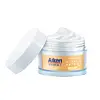What's inside
What's inside
 Key Ingredients
Key Ingredients

 Benefits
Benefits

 Concerns
Concerns

 Ingredients Side-by-side
Ingredients Side-by-side

Water
Skin ConditioningGlycerin
HumectantCetyl Ethylhexanoate
EmollientHydrogenated Polydecene
EmollientButylene Glycol
Humectant1,2-Hexanediol
Skin ConditioningPentylene Glycol
Skin ConditioningCaprylic/Capric Triglyceride
MaskingMethyl Methacrylate Crosspolymer
Vinyldimethicone
Polymethylsilsesquioxane
Squalane
EmollientAllantoin
Skin ConditioningSimmondsia Chinensis Seed Oil
EmollientAmmonium Acryloyldimethyltaurate/Vp Copolymer
Hydroxyethyl Acrylate/Sodium Acryloyldimethyl Taurate Copolymer
Emulsion StabilisingAcrylates/C10-30 Alkyl Acrylate Crosspolymer
Emulsion StabilisingHydroxyacetophenone
AntioxidantCentella Asiatica Extract
CleansingHyaluronic Acid
HumectantSodium Hyaluronate
HumectantHydrolyzed Hyaluronic Acid
HumectantButyrospermum Parkii Butter
Skin ConditioningHydrogenated Lecithin
EmulsifyingPolygonum Cuspidatum Root Extract
AntioxidantScutellaria Baicalensis Root Extract
AstringentDipotassium Glycyrrhizate
HumectantGlycyrrhiza Glabra Root Extract
BleachingCamellia Sinensis Leaf Extract
AntimicrobialCeramide NP
Skin ConditioningSodium Phytate
Rosmarinus Officinalis Leaf Extract
AntimicrobialChamomilla Recutita Flower Extract
MaskingSilica
AbrasiveSorbitan Isostearate
EmulsifyingPhenoxyethanol
PreservativeEthylhexylglycerin
Skin ConditioningCeteareth-25
CleansingCetyl Alcohol
EmollientSodium PCA
HumectantUrea
BufferingBehenic Acid
CleansingCholesterol
EmollientCeramide Ns
Skin ConditioningTrehalose
HumectantCeramide EOP
Skin ConditioningCeramide AP
Skin ConditioningPolyquaternium-51
Skin ConditioningHexylene Glycol
EmulsifyingCeramide Eos
Skin ConditioningCaprooyl Phytosphingosine
Skin ConditioningCaprooyl Sphingosine
Skin ConditioningCaprylyl Glycol
EmollientTriacetin
AntimicrobialHydroxypropyltrimonium Hyaluronate
Hydrolyzed Sodium Hyaluronate
Skin ConditioningPotassium Hyaluronate
Skin ConditioningDimethylsilanol Hyaluronate
HumectantSodium Acetylated Hyaluronate
HumectantPEG-9 Diglycidyl Ether/Sodium Hyaluronate Crosspolymer
Skin ConditioningSodium Hyaluronate Crosspolymer
HumectantSodium Hyaluronate Dimethylsilanol
HumectantPropanediol
SolventSodium Benzoate
MaskingWater, Glycerin, Cetyl Ethylhexanoate, Hydrogenated Polydecene, Butylene Glycol, 1,2-Hexanediol, Pentylene Glycol, Caprylic/Capric Triglyceride, Methyl Methacrylate Crosspolymer, Vinyldimethicone, Polymethylsilsesquioxane, Squalane, Allantoin, Simmondsia Chinensis Seed Oil, Ammonium Acryloyldimethyltaurate/Vp Copolymer, Hydroxyethyl Acrylate/Sodium Acryloyldimethyl Taurate Copolymer, Acrylates/C10-30 Alkyl Acrylate Crosspolymer, Hydroxyacetophenone, Centella Asiatica Extract, Hyaluronic Acid, Sodium Hyaluronate, Hydrolyzed Hyaluronic Acid, Butyrospermum Parkii Butter, Hydrogenated Lecithin, Polygonum Cuspidatum Root Extract, Scutellaria Baicalensis Root Extract, Dipotassium Glycyrrhizate, Glycyrrhiza Glabra Root Extract, Camellia Sinensis Leaf Extract, Ceramide NP, Sodium Phytate, Rosmarinus Officinalis Leaf Extract, Chamomilla Recutita Flower Extract, Silica, Sorbitan Isostearate, Phenoxyethanol, Ethylhexylglycerin, Ceteareth-25, Cetyl Alcohol, Sodium PCA, Urea, Behenic Acid, Cholesterol, Ceramide Ns, Trehalose, Ceramide EOP, Ceramide AP, Polyquaternium-51, Hexylene Glycol, Ceramide Eos, Caprooyl Phytosphingosine, Caprooyl Sphingosine, Caprylyl Glycol, Triacetin, Hydroxypropyltrimonium Hyaluronate, Hydrolyzed Sodium Hyaluronate, Potassium Hyaluronate, Dimethylsilanol Hyaluronate, Sodium Acetylated Hyaluronate, PEG-9 Diglycidyl Ether/Sodium Hyaluronate Crosspolymer, Sodium Hyaluronate Crosspolymer, Sodium Hyaluronate Dimethylsilanol, Propanediol, Sodium Benzoate
Water
Skin ConditioningNiacinamide
SmoothingGlycerin
HumectantBetaine
HumectantButylene Glycol
HumectantBiosaccharide Gum-1
HumectantDimethicone
EmollientCyclopentasiloxane
EmollientCarbomer
Emulsion StabilisingCyclohexasiloxane
EmollientBisabolol
MaskingAminomethyl Propanol
BufferingSodium Polyacrylate
AbsorbentXanthan Gum
EmulsifyingDisodium EDTA
Sodium Hyaluronate
HumectantDiethylhexyl Syringylidenemalonate
Skin ProtectingTrideceth-6
EmulsifyingPEG/PPG-18/18 Dimethicone
EmulsifyingMandelic Acid
AntimicrobialMelia Azadirachta Leaf Extract
Skin ConditioningCaprylic/Capric Triglyceride
MaskingPEG-40 Hydrogenated Castor Oil
EmulsifyingPolysorbate 20
EmulsifyingMelaleuca Alternifolia Leaf Oil
AntioxidantSalicylic Acid
MaskingZingiber Officinale Root Extract
MaskingAscorbyl Glucoside
AntioxidantParfum
MaskingPhenoxyethanol
PreservativeChlorphenesin
AntimicrobialWater, Niacinamide, Glycerin, Betaine, Butylene Glycol, Biosaccharide Gum-1, Dimethicone, Cyclopentasiloxane, Carbomer, Cyclohexasiloxane, Bisabolol, Aminomethyl Propanol, Sodium Polyacrylate, Xanthan Gum, Disodium EDTA, Sodium Hyaluronate, Diethylhexyl Syringylidenemalonate, Trideceth-6, PEG/PPG-18/18 Dimethicone, Mandelic Acid, Melia Azadirachta Leaf Extract, Caprylic/Capric Triglyceride, PEG-40 Hydrogenated Castor Oil, Polysorbate 20, Melaleuca Alternifolia Leaf Oil, Salicylic Acid, Zingiber Officinale Root Extract, Ascorbyl Glucoside, Parfum, Phenoxyethanol, Chlorphenesin
Ingredients Explained
These ingredients are found in both products.
Ingredients higher up in an ingredient list are typically present in a larger amount.
Butylene Glycol (or BG) is used within cosmetic products for a few different reasons:
Overall, Butylene Glycol is a safe and well-rounded ingredient that works well with other ingredients.
Though this ingredient works well with most skin types, some people with sensitive skin may experience a reaction such as allergic rashes, closed comedones, or itchiness.
Learn more about Butylene GlycolThis ingredient is an emollient, solvent, and texture enhancer. It is considered a skin-softener by helping the skin prevent moisture loss.
It helps thicken a product's formula and makes it easier to spread by dissolving clumping compounds.
Caprylic Triglyceride is made by combining glycerin with coconut oil, forming a clear liquid.
While there is an assumption Caprylic Triglyceride can clog pores due to it being derived from coconut oil, there is no research supporting this.
Learn more about Caprylic/Capric TriglycerideGlycerin is already naturally found in your skin. It helps moisturize and protect your skin.
A study from 2016 found glycerin to be more effective as a humectant than AHAs and hyaluronic acid.
As a humectant, it helps the skin stay hydrated by pulling moisture to your skin. The low molecular weight of glycerin allows it to pull moisture into the deeper layers of your skin.
Hydrated skin improves your skin barrier; Your skin barrier helps protect against irritants and bacteria.
Glycerin has also been found to have antimicrobial and antiviral properties. Due to these properties, glycerin is often used in wound and burn treatments.
In cosmetics, glycerin is usually derived from plants such as soybean or palm. However, it can also be sourced from animals, such as tallow or animal fat.
This ingredient is organic, colorless, odorless, and non-toxic.
Glycerin is the name for this ingredient in American English. British English uses Glycerol/Glycerine.
Learn more about GlycerinPhenoxyethanol is a preservative that has germicide, antimicrobial, and aromatic properties. Studies show that phenoxyethanol can prevent microbial growth. By itself, it has a scent that is similar to that of a rose.
It's often used in formulations along with Caprylyl Glycol to preserve the shelf life of products.
Sodium Hyaluronate is hyaluronic acid's salt form. It is commonly derived from the sodium salt of hyaluronic acid.
Like hyaluronic acid, it is great at holding water and acts as a humectant. This makes it a great skin hydrating ingredient.
Sodium Hyaluronate is naturally occurring in our bodies and is mostly found in eye fluid and joints.
These are some other common types of Hyaluronic Acid:
Learn more about Sodium HyaluronateWater. It's the most common cosmetic ingredient of all. You'll usually see it at the top of ingredient lists, meaning that it makes up the largest part of the product.
So why is it so popular? Water most often acts as a solvent - this means that it helps dissolve other ingredients into the formulation.
You'll also recognize water as that liquid we all need to stay alive. If you see this, drink a glass of water. Stay hydrated!
Learn more about Water